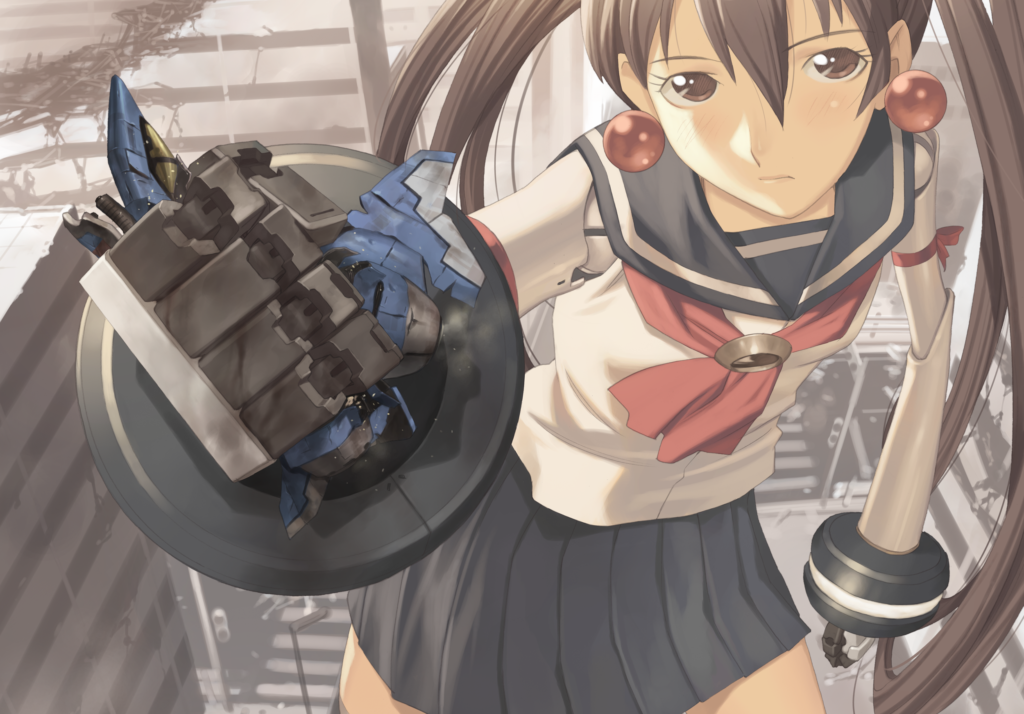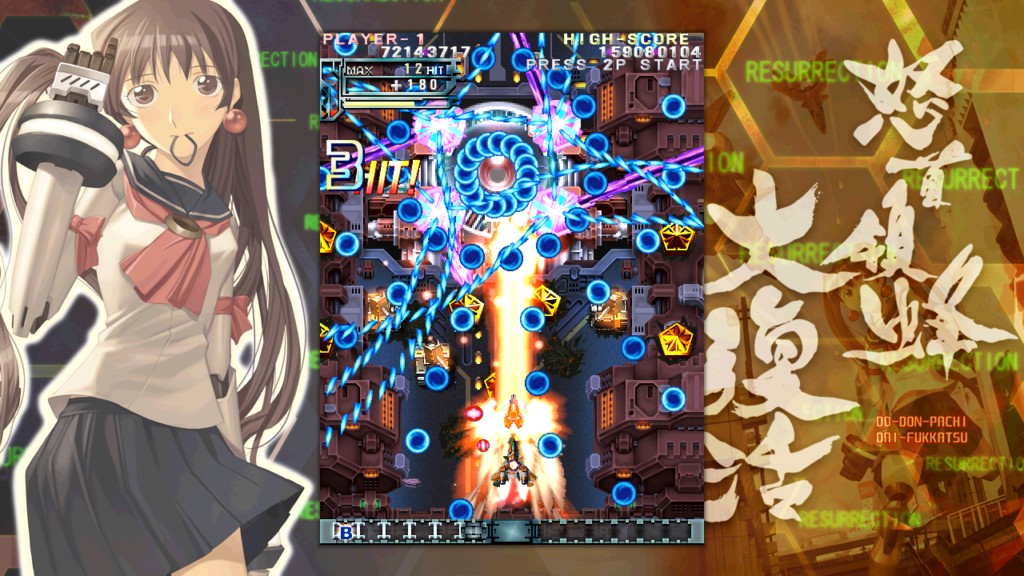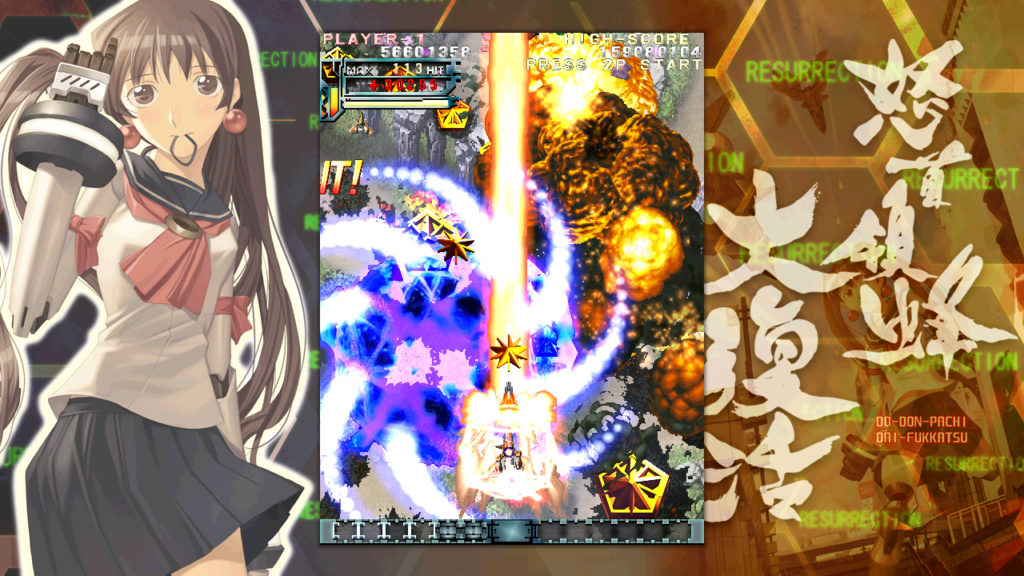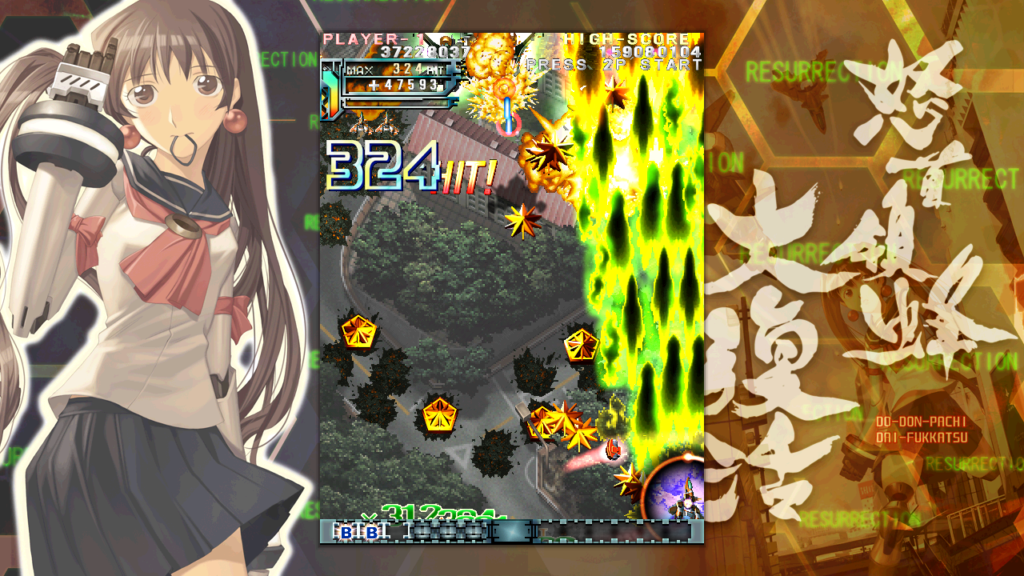I hate to say it, but I don’t really like DoDonPachi Resurrection all that much.

Known as DoDonPachi Daifukkatsu in its native home of Japan, the 2008 arcade game was supposedly CAVE’s last entry in their venerable series. As it would turn out, Saidaioujou would actually take that honor, but as a tribute to the series Resurrection tries to add a lot of new stuff to the core shooting/scoring mechanics that Saidaioujou would completely reverse. I find it strange to think that Ikeda and co. would seek to make such a radical set of changes for their “final” opus, but CAVE didn’t often rest on their laurels…at least when they were making arcade games!
But why don’t I like it? Well, let’s start at the beginning. CAVE started the manic shmup genre with DonPachi, their first game. This new trend in shooters involved massive quantities of pretty and colorful bullets being thrown at the player, who at first glance couldn’t possibly make it through the game. Yet, the saving grace appeared to be the ship’s deceptively small hit box – only a small section of the ship actually registered a hit, which meant destruction. Players began to slip through holes in the waves of flowery death with practice, bringing a rush and a thrill to the hardcore willing to go through the trouble of learning the game. DoDonPachi and DaiOuJou alike were simply slight additions to that core gameplay loop. Shoot, laser (by holding the shot button), bomb, dodge, or die – the entire series can really be encapsulated into that core formula, and I can say with certainty that its greatness lies more in the execution and iteration on the arcade shmups of old than any incredible innovation on CAVE’s part.

Beyond the simple need for survival, the entire DonPachi series is also known for its incredibly precise and difficult “chain” scoring system. Basically, killing enemies constantly garners you a chain (Denoted by the “HITS” word appearing in the upper right hand corner of the screen). There are a couple prerequisites for keeping this chain going: 1. Something must be hit by your bullets before your score meter (in the upper right hand corner of the screen) expires or 2. Your laser must be kept on a target (which will stop the degeneration of said meter). Now, this might seem easy, but destroying enemies too fast can destroy your chain. Too slow, and the chain also ends.
Playing through the levels repeatedly and understanding their layout is the only way to obtain the knowledge to succeed. It takes a lot of practice and memorization to do this at any competent level. I, for one, can’t do it well at all, and I humbly accept that I am bad at hitting enemies in sequence within a half second of each other throughout an entire stage. Still, the high skill cap means this scoring system does have an audience, and somebody will take up the mantle of the challenge – even without chaining, DonPachi games are plenty fun for survival purposes.
DoDonPachi added yet another element to this formula: Hypers. They are your best friend for scoring high, but not so much for your survival chances. Simply put, if you can get a chain going long enough, your Hyper meter will fill, and the word “Hyper” appear where your bombs would be. The hyper makes your shots glow a different color, make them more powerful, and cover a wider radius than even the highest normal upgrades. Hypers chain like crazy, bringing your score incredibly high if used correctly. However, they do something bad when activated: they increase the speed of ALL bullets. This effect (called a rank up) persists until you lose your ship, and most likely you don’t want that to happen. One must skirt the edge of getting a higher score or surviving until the next stage – lose all your lives, and your score is set in stone; continue, and it’s eliminated. Thus, judicious use of hypers is up to the player, and it’s his strategizing that makes the game even more fun. As you can see, the scoring is rather intricate, as well as integral to the gameplay (Points = extra lives!).

While this seems understandable, and DaiOuJou did little to change this, Resurrection makes a few fundamental changes that will either excite you or annoy you to death. First, Hypers are now relegated to a separate button entirely – this seems innocuous, but dealing with a four button configuration (including shot/auto-fire as two separate buttons, which is basically necessary to avoid carpal tunnel syndrome from tapping shot all day) while also trying not to die takes some getting used to. On an arcade stick, I find this configuration intensely awkward – that might seem like a really trivial detail, but plenty of shmups make complex scoring systems work without so much button clutter. For me, Resurrection’s button config is really the starting point of its greater issue: too much complexity.
See, Hypers in Resurrection also add another important detail: invincibility. And it’s here that this entry in the series jumps the shark a little bit! Activating a Hyper now makes your ship invincible for 2 whole seconds. Two whole seconds! That’s a lot of leeway time to avoid boss patterns or simply inescapable situations, and the developers definitely knew this in designing the game. Certain patterns seem to require this, and that’s an annoying thing to discover when you can’t avoid a particular bullet pattern. It appears like needless trial and error, on top of the already top-heavy trial and error of modern bullet-hell shmups. Further, regular shots in Hyper Mode now cancel bullets. This is the main scoring mechanism in every mode/variation of Resurrection, and it allows once again for the player to selectively avoid difficult bullet patterns (or, for the masochistic, to enhance their score into the many, many billions of points – scores get so high in this game that they boggle the human mind).
Something about this mechanics just doesn’t work for me, at all. It not only goes against series precedent, but it makes for some super lazy boss designs at points that assume familiarity of this dense mechanical layer. Sure, sequels should add new features for series fans and to make it more attractive in general, but is this what you really want from a DonPachi game? I don’t, and I think expectation plays a lot into Resurrection’s general reception. Add the weird “auto-bomb” into it (i.e., get hit and launch a bomb, thus suffering no penalty), and there’s a lot of weird inclusions here. Sure, you can turn it off, but why would you other than for scoring? And also, the whole “cancel lasers with other lasers” thing really irks me, because it just adds to the complexity of dodging with yet another form of cancelling.

Are they meant to bring new fans in? Because if so, CAVE made a unusually complex system more fit for experts than beginners. Further, this set of weird mechanics also acts as a crutch for new players, who won’t actually be paying all that much attention to whether they got hit or not. It’s hard to get better with auto-bomb automatically enabled, so why have it at all? In this case, the training wheels turn out to be more of a detriment than an aid. At least with Espgaluda, Kakusei mode only slowed the bullets – you weren’t fully invincible, so it simply made difficult-to-see patterns much easier to learn. In Resurrection, the mechanics on display simply remove obstacles entirely, and that just seems improper for a game subgenre so focused on dodging things. Many mechanics here get in the way of the pure joy that shmup games can produce when done right, and the bevy of hurdles to overcome for enjoyment seem a bit much. Maybe that’s not true for the vast majority of the audience for this release, but for me it is.
This also extends to every single mode variation, from the Arranges, Black Labels, and even Ketsuipachi (which, admittedly, is cool, but feels like a reference to a more complete and well-rounded title – the comparison does not flatter Resurrection at all), all of which suffer from the same mechanical underpinning. Whether it be some fundamental flaw in the mechanics or just me being terrible at it (entirely likely), I fail to find it as fun as some of CAVE’s other arcade releases like Mushihimesama, or even DoDonPachi: DaiOuJou. I find this sad, because I really want to like it, but whether for its overt complexity or just simply poorly balanced game design, it fails to find a place in my heart. And this has nothing to do with the state of the Steam port, which certainly has its own problems; I own the 360 release as well, which sits as close as you’ll get to arcade perfect outside of the original board. I tender the same feelings toward both: it just does not click for me.
Does this mean that DoDonPachi Resurrection is a bad game? On the contrary, my good fellow! I like it quite a lot. Only, I have the sneaking suspicion that this game just doesn’t fit my personal preferences. In a review, sometimes one must abandon objectivity in order to render a proper judgment. As with most games in the shmup genre, this review splits hair pretty finely – perhaps Resurrection splits hairs in a direction you happen to like. I recommend everyone give the game a shot due to its newfound accessibility in the West, but be warned that Resurrection remains the black sheep of the DoDonPachi franchise (as developed by CAVE – DoDonPachi II doesn’t count for me!).
And heck, the Black Label/Ketsuipachi soundtracks are almost reason alone to give this a purchase! But, I digress…
Anyway, I suppose DoDonPachi Resurrection does reveal one thing: CAVE is not infallible, and while they may have held the title for “most prolific shmup developers” for the majority of the 2000s, that did not mean everything they made constituted something perfect. While I think it holds some of their unique spark, it does reveal creaking complexity that simply did not need to exist for fun or even for scoring (watch somebody try to explain the scoring system, and I guarantee you’ll lose interest). But, I hope I’ve given you context to show where I’m coming from with this, and not just simply revealing myself to be a fool.
He who separates himself seeks his own desire,
He quarrels against all sound wisdom.
2 A fool does not delight in understanding,
But only in revealing his own mind.Proverbs 18
I don’t delight in given DoDonPachi Resurrection a 3/5 rating, functionally speaking. But, I can’t say that everyone will love this game, or should play it. Only you can really decide that, unfortunately – for me, it really turned into a love/hate experience to the point where I lost interest in relearning shmup muscle memory just to play a new CAVE game.
